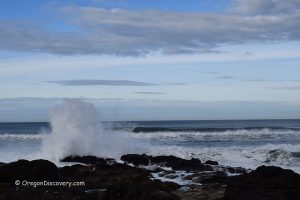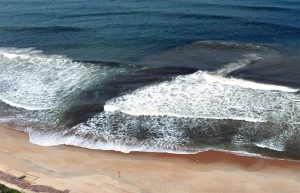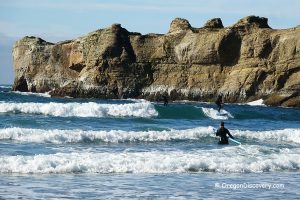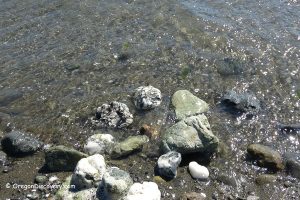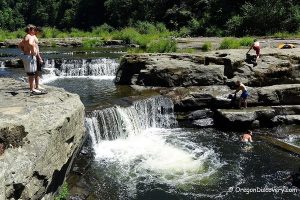• West Coast sneaker waves kill more people than all other weather hazards
• Learn about Sneaker Wave Safety & How to Survive a Sneaker Wave
According to the National Weather Service (NWS), sneaker waves on the West Coast kill more people than all other weather hazards combined. Many lives have been lost, and others have been injured by sneaker waves on the Oregon Coast. Visitors, especially children and teenagers, who comprise most victims, need to be educated on sneaker wave safety precautions.
A sneaker wave, also known as a sleeper wave, is a coastal wave that is disproportionately large and appears suddenly, without warning. It is similar to a miniature wall of water with an immensely large concentration of sand. These waves are referred to in warning and incident reports along the coasts of California, Oregon, and Washington.
The West Coast of Canada, specifically Tofino and Ucluelet, also experiences sneaker waves. In Western Australia and Tasmania, Sneaker waves are referred to as King Waves and are likened to rogue waves, surface waves originating in the middle of the ocean.
How Do Sneaker Waves Form?
While there isn’t much scientific inquiry into the phenomena, the occurrence of sneaker waves (found on the shore) can be related to that of their oceanic cousin, the rogue wave. There does not seem to be a single distinct cause but rather a combination of factors, such as high winds, strong currents, or other non-linear effects, that result in the occurrence of such a wave.
Constructive Interference
Waves travel at varying speeds; however, under certain circumstances, they can add up or 'pile up' to form one large wave that is much more massive than any 'average' wave at that time and place. A coincidence of waves and consequent reinforcement give rise to tremendously sized waves that collapse as rapidly as they emerge.
Non-linear effects
This is also known as the instability effect. The idea is that the transfer of energy between waves can cause a few huge waves to form due to the focusing of wave energy.
Why are Sneaker Waves so Dangerous?
While rare, sneaker waves can be phenomenally dangerous. They are hard to predict, appear suddenly with no prior warning or indication, and lash out with an exceptional amount of force. The sudden enlargement of the wave can catch unwary swimmers, people walking along the shoreline, and those standing on the beach and jetties, washing them out into the ocean.
Furthermore, the mixture of sand and water is similar to liquid cement, acting as a weighted anchor or even a death shroud. The high concentration of sand in the wave can saturate clothing, thus increasing its weight and consequently yours exponentially. This can weigh you down, making any escape almost impossible.
How to Protect Yourself?
How many of you enjoy peaceful walks along a shoreline? Warm beams of sunshine and the distant roars of the ocean do form the perfect combination, don’t they? Here is the issue, though: Even at a 20-yard distance from the shoreline, a sneaker wave can creep up on you.
Before you head to the Pacific Coast, check the weather forecast, tides, and whether a warning has been issued.
Oregon tide tables are available at tide-forecast.com.
Beach Hazards Statements are issued by NWS. If the warning is in effect, stay off beaches, jetties, rocks, logs, and debris.
Video
Sneaker Wave Safety & How to Survive a Sneaker Wave
- Avoid jetty rocks, mainly during high tide and storms, and when the Beach Hazards Statement is in effect
- Supervise your children and pets and stay away from the surf zone
- Do not turn your back on the ocean and avoid logs, rocks, and debris
- Watch out if an incoming wave swells higher than the previous one
- If you see the high wave is coming, move to high ground
- Carry a walking stick, umbrella, or another straight object when you walk on the beach
- If the sneaker wave comes up, do not panic, plant your walking stick into the sand as deep as possible and hang on until the wave passes
- If you are caught by the sneaker wave, swim parallel to the shore until you out of the wave, then swim toward shore.

